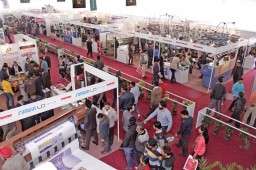
The 20th edition of KnitWorld was a success for both the participants and the visitors. It was bigger with many new and old technology manufacturers showcasing their technology from all parts of the world. Characteristically, as is the case with Ludhiana, most of the participants were flat knitting machine manufacturers, with the circular knitting technology having little but strong representation.
In StitchWorld’s coverage of KnitWorld last year, we had highlighted how indigenous semi-automatic machines, with their cost to productivity advantage, had forced the phase out of labour-dependent hand flat machines. Now it seems that the advantage of semi-automatic manufacturers has been lost to the much more versatile Chinese single system fully automatic machines, which were the major attraction for new start-ups at the fair. Costing approximately Rs. 5 lakh, these machines are much more of a value for money proposition than the semi-automatic machines which were being roughly presented for Rs. 2-2.25 lakh and are extremely limited in the structures they can knit, whereas the fully automatic single system machine, which is the most basic technology in the fully automatic flat knitting universe, can do all the designs like jacquard, intarsia, transfer, decca, at a notch higher productivity than its semi-automatic counterparts. Such machines are fast becoming the first choice, surpassing the semi-automatics, for upstarts and for those who are planning to replace their hand flats.
Jagdish Kumar Jangra, Owner of JK Jangra, who has been in the business of semi-automatic knitting solutions for over 50 years, acknowledges the threat posed by the growing popularity of single system fully computerized machines. “Even though the single system machines have not yet been able to establish themselves in the market, but they are surely going to make the market very competitive for us,” he says. However, Krishan Mastana, Owner of GK Mastana International, is still optimistic of weathering off this threat. “Manufacturers of T-shirts who only need collars or ribs, or basic sweater manufacturers like the ones producing for school uniforms, will continue to choose semi-automatic machines as the single automatic machines only have the advantage in terms of designing more patterns; productivity wise we are equal to them, plus we are more readily available for service and support,” he reasons.
For companies making fully fashioned products like ladies cardigans or sweaters, the double system flat knitting machines are ideal for knitting fully fashioned panels and theoretically they work at twice the speed. Priced at around US $ 20,000, these machines are the choice replacement for the lower technology. There is no dimensional difference between single system and double system machines. The productivity difference between the two technologies widens with the increase in the complexity of the structures to be knit.
Double system machines, in spite of being the market leader, are bested by triple system machines when it comes to efficiency. Nearly all machine manufacturers who have double system flat knitting machine in their catalogue also sell triple system machines. The advantage of using double head machine is that they can knit two panels at the same time. However, contrary to the popular belief, it doesn’t mean double the productivity.
The real advantage of these machines is when you use both the heads in “tandem” on the same long panel, for example a double head triple system machine can work as a six system machine. Even though productivity is one of the chief factors, the quality of the output, the longevity of the machine, and most importantly the price, are three aspects that influence a customer’s decision in Ludhiana. Chinese manufacturers have been able to make their mark on each of these purchasing deciders. Earlier a Chinese machine was sold on the cost advantage only, but today many Chinese brands have been able to gain the local knitter’s trust in terms of quality too, a feat which was unthinkable just 5 years back.
Few premium companies like Shima Seiki, which are the front runners in technology, set precedents which are difficult for low cost machine manufacturers to replicate. Moreover, through their innovations, they guide the industry of various possibilities with the technology. “We aim to educate customers on the versatility of the technology and present them with options that widen their understanding of different products, ranging from woollen sweaters to fine knit evening gowns in varied yarn compositions and even fashionwear from the unique ‘Wholegarment’ concept. “The collection of options available for users of the technology is immense,” said Ashwani Behl, President, Janakson International, sole dealer of Shima Seiki in India.
Ludhiana has the reputation of being the “sweater capital of the country”, so flat knitting is undisputedly preferred; and secondly, a circular knitting machine is a much heavier investment than flat knitting, therefore the Chinese seem to have totally captivated the circular knitting segment. Apart from the single jersey and double jersey machines for fabric for T-shirts, circular knitting machines which can produce fleece like fabric for blankets were also in demand.

Post a Comment